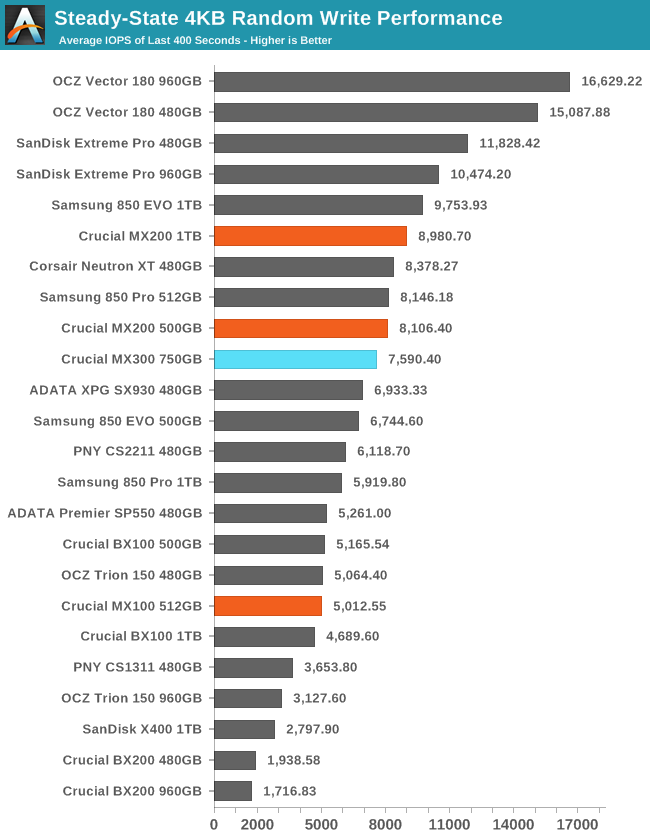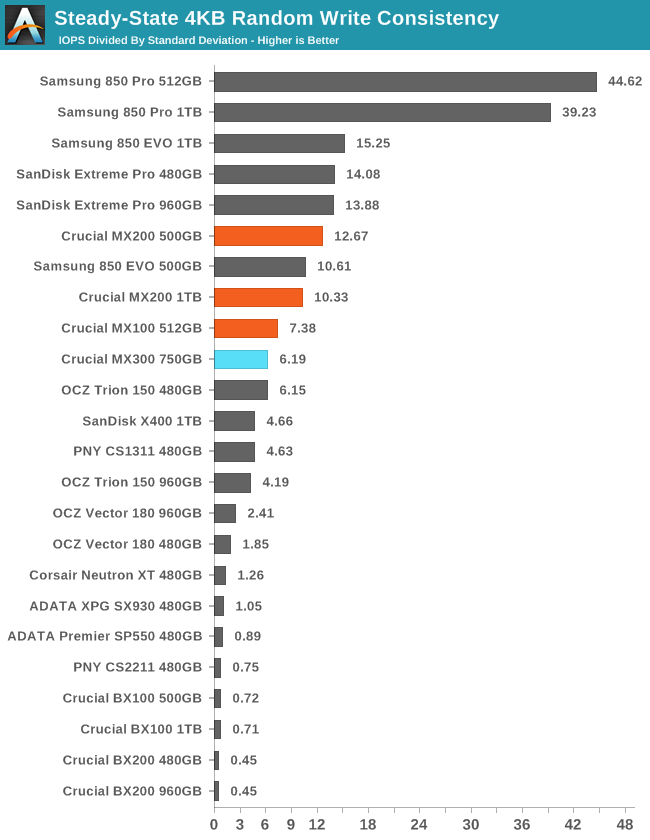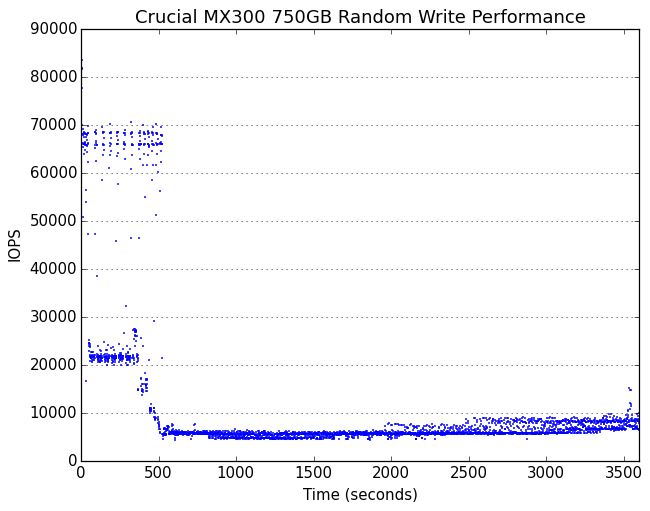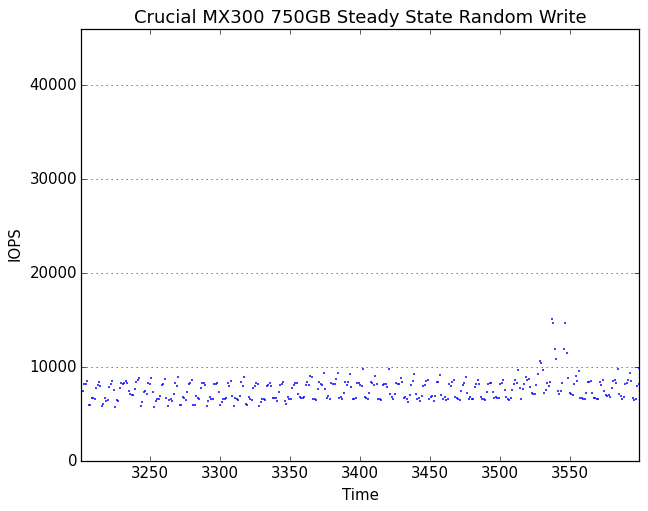The Crucial MX300 750GB SSD Review: Micron's 3D NAND Arrives
by Billy Tallis on June 14, 2016 9:00 AM ESTPerformance Consistency
Our performance consistency test explores the extent to which a drive can reliably sustain performance during a long-duration random write test. Specifications for consumer drives typically list peak performance numbers only attainable in ideal conditions. The performance in a worst-case scenario can be drastically different as over the course of a long test drives can run out of spare area, have to start performing garbage collection, and sometimes even reach power or thermal limits.
In addition to an overall decline in performance, a long test can show patterns in how performance varies on shorter timescales. Some drives will exhibit very little variance in performance from second to second, while others will show massive drops in performance during each garbage collection cycle but otherwise maintain good performance, and others show constantly wide variance. If a drive periodically slows to hard drive levels of performance, it may feel slow to use even if its overall average performance is very high.
To maximally stress the drive's controller and force it to perform garbage collection and wear leveling, this test conducts 4kB random writes with a queue depth of 32. The drive is filled before the start of the test, and the test duration is one hour. Any spare area will be exhausted early in the test and by the end of the hour even the largest drives with the most overprovisioning will have reached a steady state. We use the last 400 seconds of the test to score the drive both on steady-state average writes per second and on its performance divided by the standard deviation.

The MX300's steady state random write performance is below the MX200 but stays slightly ahead of the 850 EVO and well ahead of any planar TLC drive.

The MX300 earns a consistency score that is below the MX200 but about average, and certainly high enough for ordinary consumer workloads.
 |
|||||||||
| Default | |||||||||
| 25% Over-Provisioning | |||||||||
The MX300 lasts for over eight minutes before the SLC cache and spare area are completely exhausted, but during that phase it alternates between operating at about 22k IOPS and 65-70k IOPS. During the steady state phase there is gradual improvement in performance along with an increase in variability.
 |
|||||||||
| Default | |||||||||
| 25% Over-Provisioning | |||||||||
The steady state random write performance of the MX300 varies periodically between about 6k IOPS to 10k IOPS, with no outliers of slow performance. With extra overprovisioning performance is substantially higher and consistency is a bit better.










85 Comments
View All Comments
fanofanand - Tuesday, June 14, 2016 - link
Slower and more expensive than the competition. Bravo Micron/Intel! Bravo!ddriver - Tuesday, June 14, 2016 - link
They have no choice but to get realistic about the price.TheinsanegamerN - Tuesday, June 14, 2016 - link
Other SSD manufacturers are living in la-la land then? Because other OEMS seem to have no trouble selling SSDs for less.Arnulf - Tuesday, June 14, 2016 - link
They should get realistic about their naming as well - this is clearly a BX300 ... Or perhaps a BX298.32, given more crappy performance considering the BX100 ...Oxford Guy - Friday, July 8, 2016 - link
The drive beats the 850 EVO in the power consumption (except idle) tests, though. So, if the drive is going to be used in a laptop that doesn't idle much it could be a potential choice over the Samsung based on that.barleyguy - Tuesday, June 14, 2016 - link
I was hoping it would be faster than the MX200. I have 3 of those.It's top of the charts in power efficiency though, so it might be a great choice for a laptop. The performance difference is probably barely noticeable in real world use, but the battery life advantage might be tangible.
Also, launch price is $199 for 750 GB, which is not bad at all.
chrisso - Friday, June 17, 2016 - link
I also use an MX 200,which actually only has a write speed of 330.I suspect launch price is a suits guestimate at selling point.
Real world differences are indeed minimal, price will be the main selling point later for the mainstream crowd (me).
chrisso - Friday, June 17, 2016 - link
(my drive IS the humble 256 gig, btw). I would buy a 750 later as pointed out,prices are a tumbling.eek2121 - Tuesday, June 14, 2016 - link
Prices quoted are MSRP, as an example, the Trion 150 listed above debuted at 38.5 cents per gb. Don't be surprised to see this drive drop below 20 cents a gig in a few months.Gondalf - Wednesday, June 15, 2016 - link
Strange comment. Anandtech article is not negative at all about this SSD driver, Techreport too says "recommended" at the end of the review.So you are a little biased in my opinion.